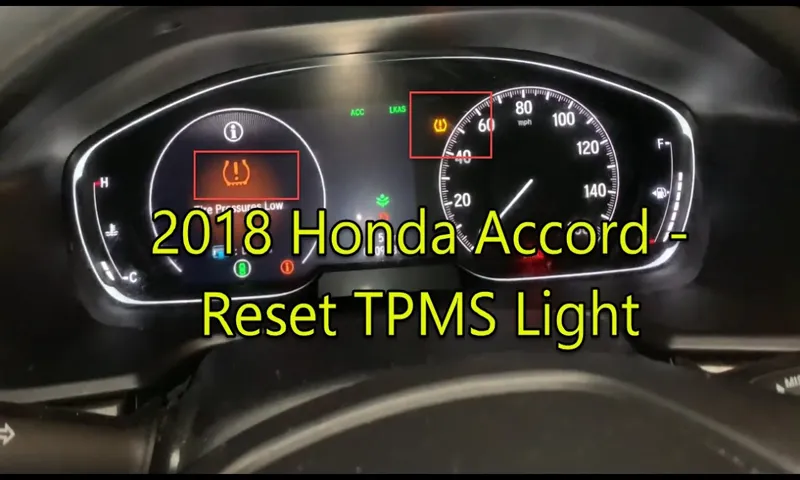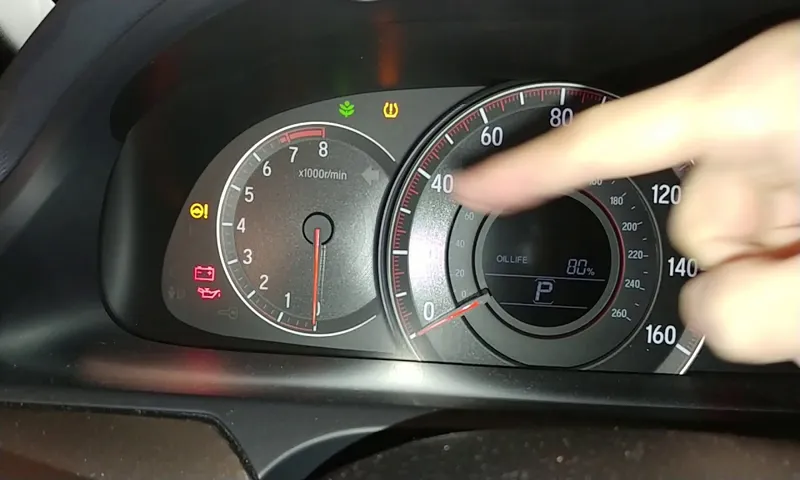If you’re a Honda Accord owner, you may notice that the tire pressure light on your dashboard has illuminated. While this may cause panic, it’s a common issue that can easily be remedied. A blinking or steady tire pressure light alerts the driver when one or more tires has low air pressure, which can affect your car’s performance and safety.
But don’t worry! Removing the tire pressure light on your Honda Accord is a quick and easy fix, and our team is here to help you navigate the process. In this blog post, we’ll provide you with accurate and easy-to-follow instructions on how to remove the tire pressure light on your Honda Accord, so you can have peace of mind knowing your car is safe and ready to drive.
Check the Tire Pressure
If you’re wondering how to remove tire pressure light on your Honda Accord, the first step is to check the tire pressure. Low tire pressure is one of the most common reasons for the light to come on, so it’s essential to make sure your tires have the correct pressure. You can use a tire pressure gauge to check the pressure levels in each tire.
If the pressure is too low, inflate the tire to the recommended pressure level, which can be found in your car’s owner’s manual or on a sticker inside the driver’s side doorjamb. Checking your tire pressure regularly not only helps prevent the tire pressure light from coming on but also ensures your safety on the road and improves fuel efficiency. It’s easy to forget about your tires, but they play a critical role in your car’s performance, so make sure to check them regularly.
By doing so, you’ll be more aware of any potential issues and ensure your Honda Accord performs its best.
Use a Tire Pressure Gauge
When it comes to maintaining your vehicle’s safety and performance, checking the tire pressure is crucial. Using a tire pressure gauge is an easy and accurate way to measure the pressure in your tires. With the right tool, you can easily determine if your tires are inflated to the manufacturer’s recommended level.
Maintaining proper tire pressure not only helps your vehicle handle better, but it also improves fuel efficiency, extends tire life, and reduces the risk of a blowout. It’s important to remember that tire pressure fluctuates with changes in temperature and altitude, so it’s important to check them regularly. By taking a few minutes to check your tire pressure using a gauge, you can ensure your vehicle is safe and performing at its best.

Add or Release Air as Needed
Checking tire pressure is one of the simplest and most important maintenance tasks for any vehicle owner. A tire that is underinflated or overinflated can lead to safety issues such as decreased traction, decreased fuel efficiency, or even a blowout. That’s why it’s essential to check tire pressure regularly.
To get an accurate reading, the tire should be cool, so it’s best to check the pressure either in the morning or after the vehicle has been sitting idle for a few hours. Use a tire pressure gauge to check the pressure of each tire. If the pressure is low, add air until it reaches the recommended pressure level, which is typically found in the owner’s manual or on a sticker located on the driver-side door jamb.
If the pressure is too high, release air until it reaches the recommended level. By keeping tire pressure at the recommended level, you will not only ensure your tires last longer but also improve fuel efficiency and enhance safety on the road.
Reset the Tire Pressure Monitoring System
Are you tired of seeing that pesky tire pressure light constantly illuminated on your Honda Accord’s dashboard? While you shouldn’t ignore it as it could indicate a serious issue, you can easily reset the tire pressure monitoring system yourself. First, make sure all tires are properly inflated to the manufacturer’s recommended pressure. Then, locate the tire pressure monitoring system reset button, which is typically found in the glove box or under the steering wheel.
Press and hold the button until the light blinks twice, indicating that the system has been reset. If the light continues to appear, it may be time to get your tires inspected by a professional. By staying on top of your Honda Accord’s tire pressure, you can improve fuel efficiency, extend the life of your tires, and keep yourself safe on the road.
Stop the Car in a Safe Location
Resetting the tire pressure monitoring system is an important task that must be done when you replace your vehicle’s tires or when the tire pressure warning light illuminates on your dashboard. To reset the system, first, stop the car in a safe location away from traffic. Once you have done this, turn off the engine and engage the parking brake.
Next, locate the reset button, which is usually found on the dashboard below the steering wheel. Press and hold the reset button until the signal light begins to blink, which indicates that the system has been reset. Finally, start the car and check if the warning light has turned off.
If the light is still on, it may take some time for the system to reset completely. Organic keyword: tire pressure monitoring system.
Turn the Ignition On
If your vehicle’s tire pressure monitoring system (TPMS) light is on, it’s crucial to reset it promptly. This indicator light warns you when the air pressure in one or more of your car’s tires drops below the recommended level. Low tire pressure can affect your vehicle’s handling, increase fuel consumption, and even cause tire damage.
To reset the TPMS, first, turn the ignition key into the “On” position without starting the engine. Then, locate the reset button, which is typically found under the steering wheel or glove box. Press and hold the reset button until the TPMS light blinks twice, indicating that the system has been reset successfully.
If you don’t have a reset button, you can try deflating each tire to zero psi and then inflating them back to the recommended pressure. However, this method may not work for all vehicles. It’s crucial to check your vehicle’s owner manual for specific instructions on resetting your TPMS properly.
Remember to check your tire pressures regularly to ensure they’re properly inflated and prevent the TPMS light from reoccurring. By resetting your TPMS, you can drive with peace of mind, knowing that your tires are balanced and safe.
Press the TPMS Reset Button
If you’re driving around with a tire pressure monitoring system (TPMS) light popping up on your dashboard, it’s time to press the reset button! This simple procedure clears your TPMS of any previous tire pressure data and recalibrates it to the current air pressure levels in your tires. Not only does this ensure that your tires are performing optimally, but it also keeps you safe on the road. To reset your TPMS, consult your vehicle’s owner manual for specific instructions as the process may vary based on make and model.
Once you find the reset button, press and hold it for a few seconds until the TPMS light blinks and then stays on solidly. Release the reset button, turn your vehicle off, and then back on again to allow the recalibration to take effect. Remember, regularly checking your tire pressure and resetting your TPMS when necessary is essential for maintaining a smooth, stable ride that’s both fuel-efficient and safe on the road.
Wait for the Light to Blink
If you have ever noticed a light flashing on your dashboard, it could be a sign that your Tire Pressure Monitoring System (TPMS) needs to be reset. The TPMS is a safety system that alerts you when one or more of your tires is underinflated. This is important because underinflated tires can cause increased wear and tear, reduced fuel economy, and even accidents.
To reset the TPMS, start by ensuring that all of your tires are properly inflated to the manufacturer’s recommended pressure. Next, turn your ignition on without starting your car and wait for the TPMS light to start blinking. Once it starts blinking, hold down the TPMS reset button until the light stops flashing.
The process should only take a few minutes, but it’s essential for maintaining the safety of your vehicle and prolonging the life of your tires.
Start the Car and Drive
Do you hate getting that annoying tire pressure warning light on your car’s dashboard? It’s essential to reset the tire pressure monitoring system (TPMS) whenever you inflate or change your tires. The process is quite easy and straightforward. First, locate the TPMS reset button, usually found under the dashboard or in the glove compartment.
Next, start the car and drive for a few minutes to initiate the system’s calibration. Once the calibration process is complete, the TPMS warning light will turn off. You should note that different car models have different TPMS reset procedures, so it’s essential to familiarize yourself with your vehicle’s manual.
Neglecting the TPMS can result in unsafe driving conditions, such as tire blowouts and poor fuel efficiency. Regularly checking your tire pressures and resetting the TPMS after tire changes can ensure your car’s safe and efficient performance.
Conclusion
Removing the tire pressure light on your Honda Accord may seem like a daunting task, but fear not! With a little elbow grease and some clever problem solving, you too can say goodbye to that pesky warning sign. Whether it’s checking your tire pressure, replacing a faulty sensor, or resetting the system, there are multiple solutions available to ensure you hit the road safely and free from bothersome lights. So, don’t let a tire pressure light cramp your style! Follow these easy steps and you’ll be back on the open road in no time.
“
FAQs
What does the tire pressure light in a Honda Accord indicate?
The tire pressure light in a Honda Accord indicates that one or more of the tires is below the recommended pressure level.
How do I check the tire pressure in my Honda Accord?
To check the tire pressure in your Honda Accord, you’ll need a tire pressure gauge. Remove the valve cap from each tire and place the gauge over the valve stem. The gauge will display the current tire pressure.
How much air pressure should I put in my Honda Accord’s tires?
The recommended tire pressure for a Honda Accord is usually between 32-35 psi, but it’s always best to check your owner’s manual or the sticker on the driver’s side door jamb for the specific recommendation for your vehicle.
What should I do if my Honda Accord’s tire pressure light comes on?
If the tire pressure light comes on in your Honda Accord, check the tire pressure in all four tires. If one or more of the tires is low, fill them to the recommended level. If the light stays on, you may need a tire repair or replacement.
Can the tire pressure light reset itself in a Honda Accord?
Yes, the tire pressure light in a Honda Accord can reset itself after the tire pressure is corrected. However, it may take several miles of driving before the light turns off.
Can cold weather affect my Honda Accord’s tire pressure?
Yes, cold weather can cause the tire pressure in your Honda Accord to drop. It’s important to check your tire pressure regularly during colder months to make sure it’s at the recommended level.
Can I turn off the tire pressure light in my Honda Accord without fixing the issue?
It’s not recommended to turn off the tire pressure light in your Honda Accord without fixing the issue. The light is a warning that something is wrong with your tires and ignoring it could lead to further damage or even a blowout.

